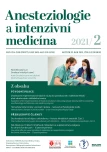Evaluation of the implementation of medical simulations into postgraduate training before completing anesthesiology and intensive care residency program
Authors:
T. Prokopová 1,2; K. Vrbica 1; J. Hudec 1; J. Dvořáček 1,2; R. Gál 1; J. Maláska 1,2
Authors‘ workplace:
Klinika anesteziologie, resuscitace a intenzivní medicíny, Lékařská fakulta Masarykovy univerzity, a Fakultní nemocnice Brno
1; Centrum pro rozvoj klinických kompetencí, Lékařská fakulta Masarykovy univerzity, Brno
2
Published in:
Anest. intenziv. Med., 32, 2021, č. 2, s. 74-81
Category:
Original Article
Overview
Objective: Successful completion of a simulation course on critical states has recently become required in Anaesthesiology and Intensive Care Board Certification process. Firstly, the objectives of this study were to compare data from self-assessment questionnaires answered by the participants before and after completing high-fidelity simulations and, secondly, to evaluate the perception of these simulations by young trainees and whether they will have an effect on their interest in continuing such a training.
Design of the study: Observational; Survey research.
Setting of the study: Department of Anesthesiology at University Hospital.
Materials and methods: The target group were trainees enrolled in the residency training program at our department. Each of them completed two high-fidelity simulation sessions. The clinical scenarios focused on emergencies in anesthesiology i.e. difficult airway management and complications of regional anaesthesia. The simulations were held in an actual operat ing theatre with complete equipment and participating nurse anaesthetists at all times. Overall performance and skills of each trainee and the nurse were assessed, including their level of cooperation. A structured debriefing providing feedback to the participants was held following each simulation. For study purposes, each trainee answered two questionnaires (one preceding the first simulation and the other following the second). The questions aimed at self-assessment and evaluation of the course as such. Methods of descriptive statistics processed the results.
Results: All of 14 residents enrolled in postgraduate training at our institution had participated in the study. Each of them expressed interest in increasing the frequency of training sessions following the simulations; 13 (93 %) felt motivated to gain new theoretical knowledge. All participants were interested in completing additional simulations.
Conclusion: Despite the relatively small study population, the survey demonstrated this education concept very well accept ed. Simulations instigate trainees to deepen their theoretical knowledge and practical skills. From this perspective, medical simulations do have their place in postgraduate training, and their implementation could have a share in increasing erudition in our field.
Keywords:
medical simulation – postgraduate training – Education – survey
Sources
1. Al‑Elq AH. Simulation‑based medical teaching and learning. J Fam Community Med. 2010; 17(1): 35–40. doi: 10.4103/1319-1683.68787
2. Boling B, Hardin‑Pierce M. The effect of high‑fidelity simulation on knowledge and confidence in critical care training: An integrative review. Nurse Educ Pract. 2016; 16(1): 287– 293. doi: 10.1016/j.nepr.2015. 10. 004
3. Parsons JR, Crichlow A, Ponnuru S, Shewokis PA, Goswami V, Griswold S. Filling the Gap: Simulation‑based Crisis Resource Management Training for Emergency Medicine Residents. West J Emerg Med. 2018; 19(1): 205–210. doi: 10.5811/westjem.2017. 10. 35284
4. Bond WF, Spillane L. The Use of Simulation for Emergency Medicine Resident Assessment. Acad Emerg Med. 2002; 9(11): 1295–1299. doi: 10.1197/aemj.9. 11. 1295
5. Small SD, Wuerz RC, Simon R, Shapiro N, Conn A, Setnik G. Demonstration of high‑fidelity simulation team training for emergency medicine. Acad Emerg Med Off J Soc Acad Emerg Med. 1999; 6(4): 312–323. doi: 10.1111/j.1553-2712.1999.tb00395.x
6. Jentsch F, Curtis M. Simulation in Aviation Training. 1st Ed. Routledge; 2017.
7. Lester E, Georgiou A, Hein M, Littlepage G, Moffett R, Craig P. Improving Aviation Students’ Teamwork, Problem Solving, Coordination, and Communications Skills During a High‑Fidelity Simulation. 19th Int Symp Aviat Psychol. 2017; 119–124. https://corescholar. libraries.wright.edu/isap_2017/49
8. Bond WF, Lammers RL, Spillane LL, Smith‑Coggins R, Fernandez R, Reznek MA, et al. The Use of Simulation in Emergency Medicine: A Research Agenda. Acad Emerg Med. 2007; 14(4): 353–363. doi: 10.1197/j.aem.2006. 11. 021
9. Klincová M, Trčková A, Chlupová J, Jor O, Klabusayoá E. Pohled mladých anesteziologů a intenzivistů na specializační vzdělávání v oboru anesteziologie a intenzivní medicína v České republice: dotazníková studie. Anest. a intenziv. Med. 2019; 30(3–4): 162–169.
10. Veselá L. Každý pátý medik plánuje pracovat v cizině, odhalil průzkum. Portál idnes. cz [online]. 2019. Dostupné z: https://www.idnes.cz/zpravy/domaci/zdravotnictvi‑ lekari‑medici‑zdravotnictvi‑nedostatek‑lekaru. A190410_123108_domaci_linv
11. Ministerstvo zdravotnictví České republiky. Anesteziologie_a_intenzivní_medicína_ Věstník_MZ_2019_specializovaný_výcvik. Portál mzcr.cz [online]. 2019. Dostupné z: https://www.mzcr.cz/vzdelavaci‑programy- 2019-lekari/
12. Shailaja S, Hilda S, Pinto P, D’Cunha R, Mahmood L, Hegde R. Evaluation of resident satisfaction and change in knowledge following use of high‑ fidelity simulation teaching for anaesthesia residents. Indian J Anaesth. 2019; 63(11): 908. doi: 10.4103/ ija.ija_133_19
13. Morgan P, Tarshis J, LeBlanc V, Cleave‑Hogg D, DeSousa S, Haley MF, et al. Efficacy of high‑fidelity simulation debriefing on the performance of practicing anaesthetists in simulated scenarios. Br J Anaesth. 2009; 103(4): 531–537. doi: 10.1093/bja/aep222
14. Paige J, Kozmenko V, Yang T, Gururaja RP, Hilton ChW, Cohn I jr., et al. High‑fidelity, simulation‑based, interdisciplinary operating room team training at the point of care. Surgery 2009; 145(2): 138–146. doi: 10.1016/j.surg.2008. 09. 010
15. Motola I, Devine LA, Chung HS, Sullivan JE, Issenberg SB. Simulation in healthcare education: a best evidence practical guide. AMEE Guide No. 82. Med Teach. 2013; 35(10): e1511–e1530. doi: 10.3109/0142159X.2013.818632
16. Turner S, Harder N. Psychological Safe Environment: A Concept Analysis. Clin Simul Nurs. 2018; 18: 47–55. doi: 10.1016/j.ecns.2018. 02. 004
Labels
Anaesthesiology, Resuscitation and Inten Intensive Care MedicineArticle was published in
Anaesthesiology and Intensive Care Medicine

2021 Issue 2
Most read in this issue
- Timing of surgery following SARS‑CoV- 2 infection: an international prospective cohort study.
- Blocks of cutaneous nerves and fascias layout of the thigh
- Hemodynamic changes in prone position – a non‑invasive physiological study
- Neinvazivní a invazivní monitorace hemodynamiky na jednotce intenzivní péče
